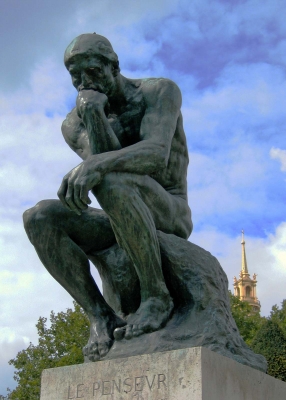
The Thinker, French Le Penseur, sculpture of a pensive nude male by French artist Auguste Rodin, one of his most well-known works. Many marble and bronze editions in several sizes were executed in Rodin’s lifetime and after, but the most famous version is the 6-foot (1.8-metre) bronze statue (commonly called a monumental) cast in 1904 that sits in the gardens of the Rodin Museum in Paris. The large muscular figure has captivated audiences for decades in his moment of concentrated introspection.
The Thinker has been cast in multiple versions and is found around the world, but the history of the progression from models to castings is still not entirely clear. About 28 monumental-sized bronze casts are in museums and public places. In addition, there are sculptures of different study-sized scales and plaster versions (often painted bronze) in both monumental and study sizes. Some newer castings have been produced posthumously and are not considered part of the original production.
Rodin made the first small plaster version around 1881. The first full-scale model was presented at the Salon des Beaux-Arts in Paris in 1904. A public subscription financed a bronze casting in 1906, which became the property of the City of Paris, and was put in front of the Panthéon. In 1922, it was moved to the Hôtel Biron, which had been transformed into the Rodin Museum.
A bronze cast of the sculpture can be found in front of Grawemeyer Hall on the University of Louisville Belknap Campus in Louisville, Kentucky. It was made in Paris and was first displayed at the St. Louis World’s Fair in 1904, then given to the city. This sculpture was the only cast created by the lost-wax casting method.
Picture Credit : Google

